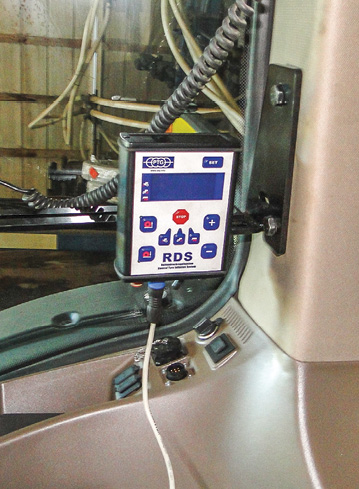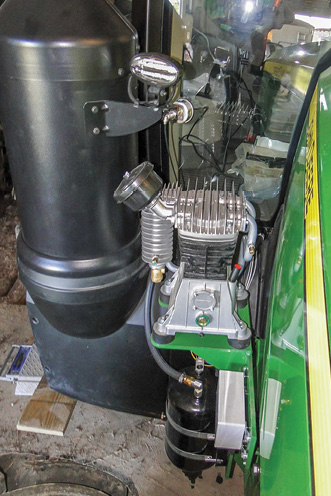With market realities causing American grain farmers to plug in $3 corn to their spread sheets in place of $7, the machinery industry has seen a rapid slowing of demand for new, increasingly efficient farm equipment as producers defer replacing machinery and scramble to cut expenses.
While deferring expensive purchases to save money, many North American producers apparently have been overlooking some popular European retrofit technology that can help them boost yields, reduce inputs, save time in the field and make tires and equipment last longer — Central Tire Inflation Systems (CTIS).
Currently in the U.S., only Fendt offers CTIS on its tractors with flange axles and single tire mounts as an option. Meanwhile, several models of John Deere tractors in Europe are equipped with ISOBUS-based systems built by German manufacturer PTG to meet the growing popularity of in-cab control of front and rear tire pressure to meet varying demands of transport or in-field conditions.
In the U.S., ISOBUS technology compatibility problems have been a stumbling block in the widespread adoption of CTIS. Still, retrofit CTIS is available to U.S. producers and it can be adapted to tractors, planters and manure haulers to increase transport speeds and reduce field compaction.
PTG recently began working with New Holland to provide a CTIS option on new equipment in the U.S. That system will use a drilled axle specifically designed for providing air pressure to wheels, says Sally Brodbeck, owner of Precision Inflation (www.precisioninflation.com) in West Des Moines, Iowa, a distributor for PTG systems.
Also, the company will soon begin supplying an airbox system, which fits over the end of the axle and uses external pneumatic lines, for use on all combine brands used in the U.S. “The airbox system provides very durable, cost-effective and easy-to-install CTIS technology to harvesters.”
She says the installation of CTIS on farm equipment offers producers facing tighter margins and lower commodity prices the “best bang for their buck” in getting every dollar out of their acres.
 Producers adding CTIS retrofit systems will find the controller to be an intuitive, unobtrusive addition to their cab. |
 The power behind the PTG add-on CTIS system is a high capacity hydraulically driven compressor, capable of inflating or deflating equipment tires to the desired pressure in about five minutes. |
“This technology is changing how agriculture is done in Europe, and it’s coming to the U.S. in short order,” she explains, noting the benefits of easily adjustable tire pressure include, reduced tire wear, improved traction, reduced field compaction, along with less time in the field. Also, proper tire inflation increases flotation in soft or wet spots, and reduces wear and tear on equipment caused by power hop and slippage.
“Farmers I’ve visited with in Iowa tell me they have seen a 30 bushel per acre yield reduction when they are combining out wheel tracks in their field,” she explained, highlighting the profit drag of compacted fields caused by running too much pressure in equipment tires.
“This is even a bigger problem where producers are running smaller equipment and therefore make more trips in the field. The reductions are spread more evenly through the field, leading many producers to chalk up the yield reductions to field variability instead of something they can correct.”
With CTIS these growers could be increasing yields with their existing equipment without making the much more expensive purchase of new, larger tractors or track sets, she says.
Similarly, John Casner, with Inflation Solutions (www.inflationsolutions.com), Fletcher, Ohio, also is a PTG sales representative. He says his company’s studies show running a 16-row, 40-foot front-fold corn planter in the field with the same high pressure as on the road can cost a producer more than 30 bushels per acre on pinch rows, due to compaction.
“Every tire has an ideal air pressure based on weight exchange and weight needed to achieve 100% performance,” Casner explains. “But many farmers aren’t maximizing that potential and that can cost them yield.”
Soil compaction and its yield-drag is becoming much more well known on both sides of the Atlantic, particularly as equipment gets larger and heavier, says James Crouch, farm segment marketing manager with Michelin.
“Right now many farmers set up their tire inflation for the worst-case scenario, for maximum load and maximum speed, where they should be inflating for the best-case situation — changing the inflation for optimum pressure on the road and lowering it for the field to create a larger footprint and less compaction,” he says.
Brodbeck says properly inflating equipment tires on the road and in the field can increase overall fuel economy by 10% and it can add many hours to the life of expensive tires.
“In addition,” she says, “even if you don’t have expensive IF or VF tires, by properly inflating the tires you use, you can make them perform more like the high flexion models. If you have IF or VF tires, CTIS can help you get better performance out of them in all situations. This can be incredibly inexpensive when compared with buying new equipment or tracks. It’s pennies on the dollar for the system.”
While tracks reduce soil compaction by spreading the load of a tractor over more field area, Brodbeck says once you install tracks you have one ground pressure, and unless what you’re pulling has tracks, you haven’t solved your problem.
“With CTIS it’s possible to get maximum performance from precision inflation on the tractor, planters, sprayers and heavy manure haulers.” The technology is moving rapidly into harvesting equipment also, she notes.
Although Brodbeck says growers can begin adding CTIS to equipment for as low as $300 for a plug and go one-axle system (plus a compressor), she and Casner say the cost of full-blown in-cab on-the-go CTIS can range from $12,000-$20,000 figures, that so far, have kept CTIS a low priority for U.S. farmers.
Still, Brodbeck and Casner say most CTIS customers see a full return on their investment in CTIS technology within two years, and, along with Crouch, expect the market for the systems to grow rapidly in North America as producers seek to maximize their economic efficiency.
“I’m sure OEMs are working on long-term projects to bring this technology to North America because there is such a benefit,” Crouch says. “It’s inevitable we’ll see it here soon.”
|
CTIS: Developed for the Battlefield |






